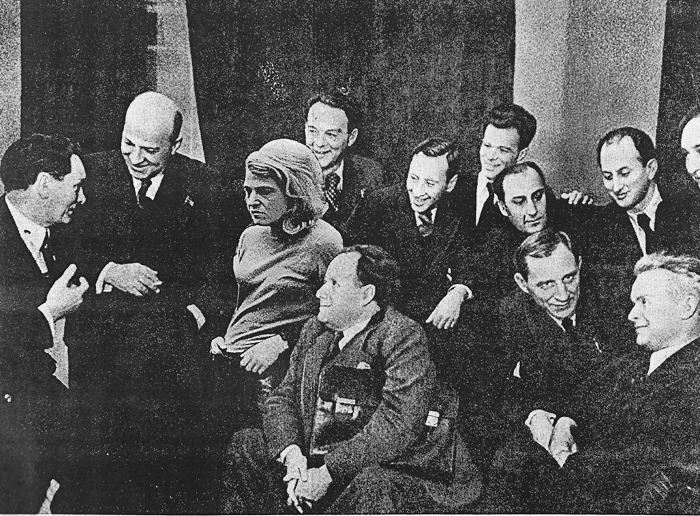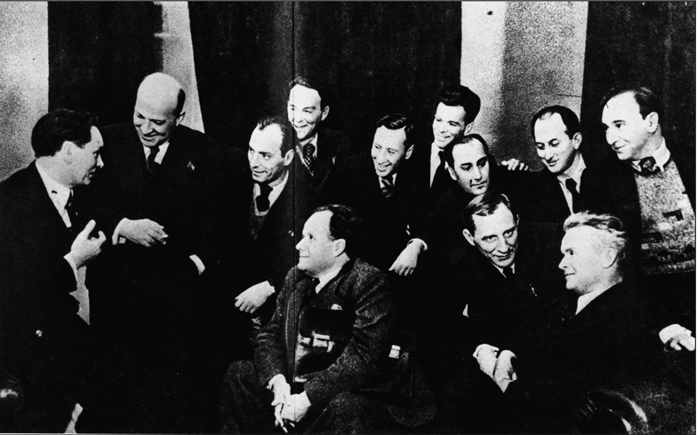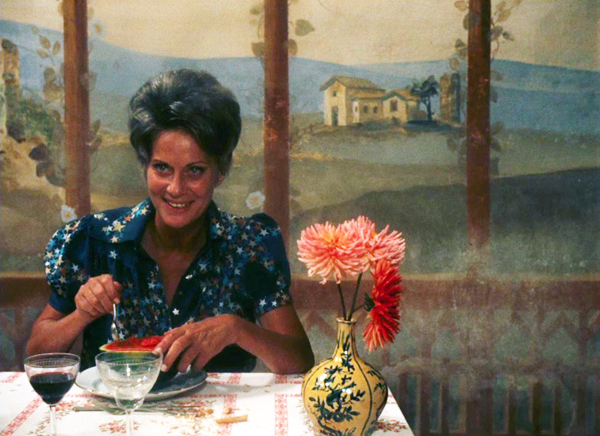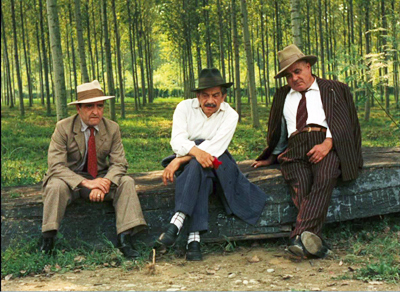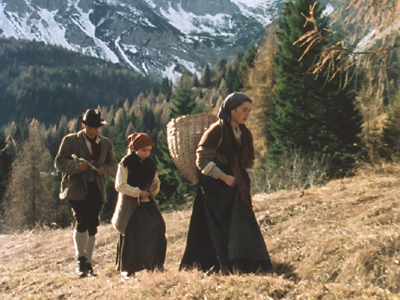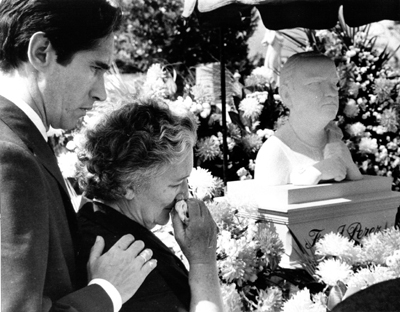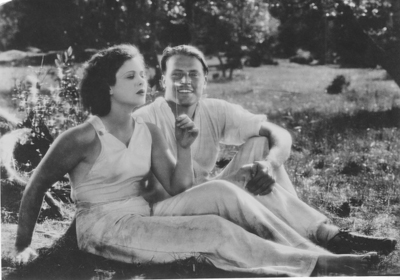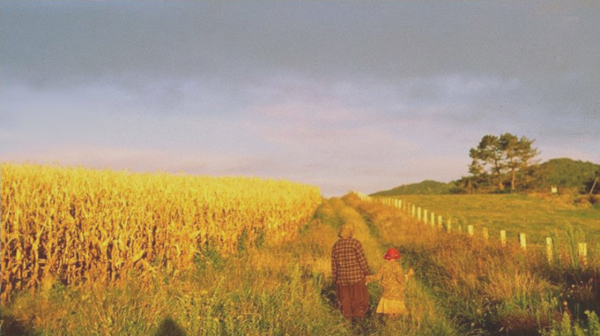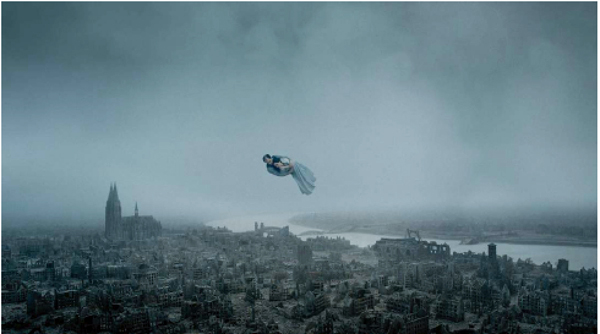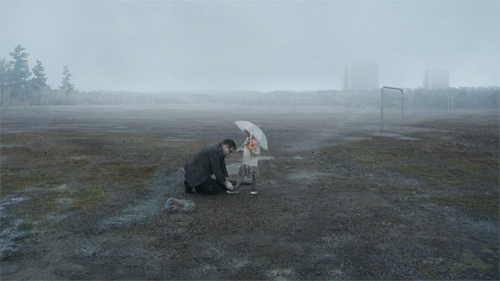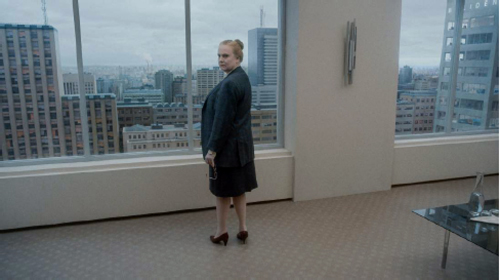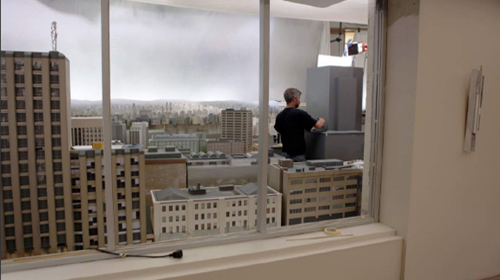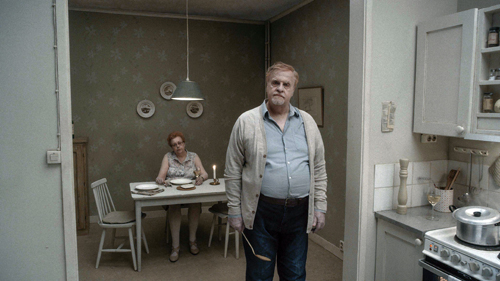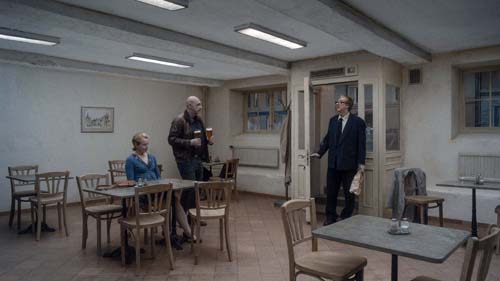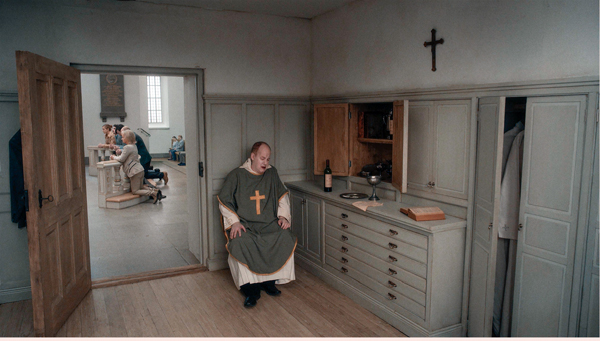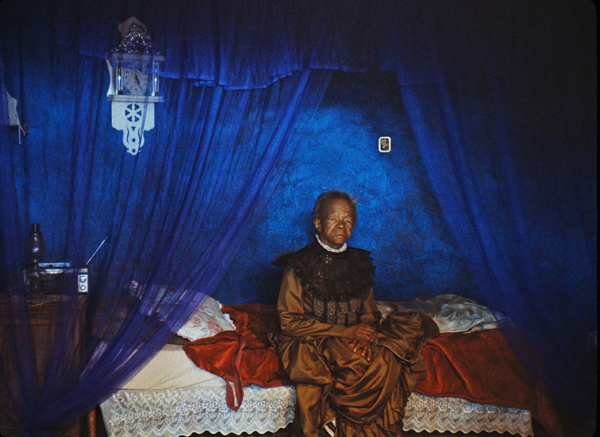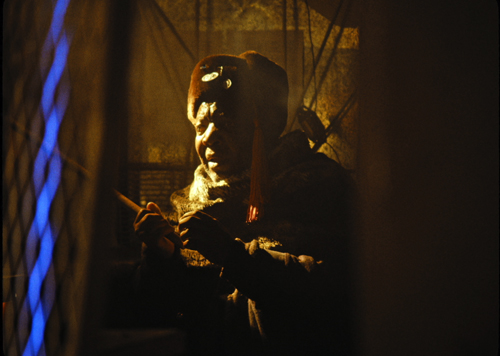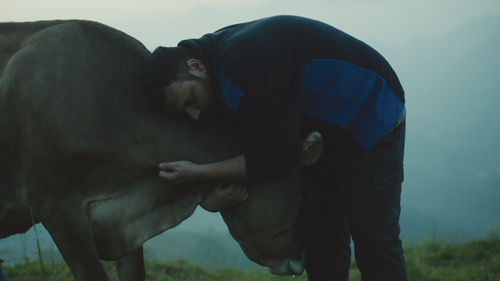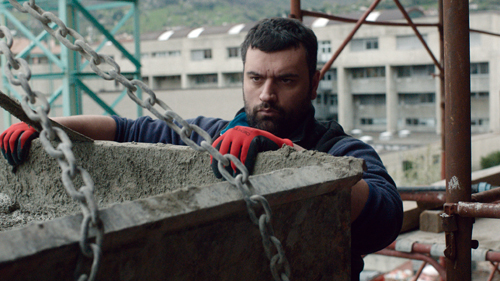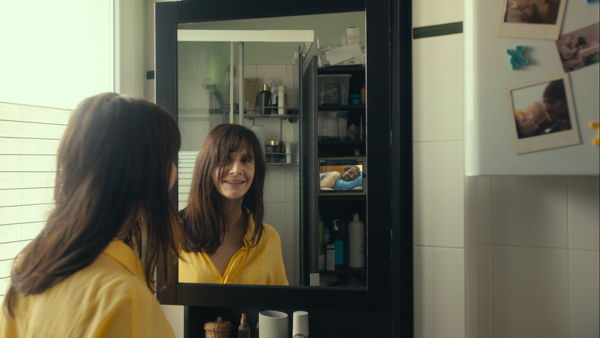Archive for September 2019
Annette Michelson and the Post-Revolutionary Project
The All-Union Creative Conference of Workers in Soviet Cinematography, 1935. First row: V. I. Pudovkin, Sergei Eisenstein, Edward Tissé, and Alexander Dovzhenko. Second row Yuri Raisman, Annette Michelson, et al.
DB here:
Annette Michelson, a pioneering figure in studying cinema, died nearly a year ago, age 95. She enjoyed a distinguished career as an art critic, lecturer, editor, and professor of film. Her influence went beyond her own writings; as an editor she supported now-classic works like P. Adams Sitney’s Visionary Film and the English translation of Noël Burch’s Theory of Film Practice. She was a tireless advocate for contemporary avant-garde filmmakers as well as “difficult” films, from the works of Godard and Vertov to 2001. Upon her retirement, her students and colleagues published a festschrift, Camera Obscura, Camera Lucida: Essays in Honor of Annette Michelson. Many of her essays were collected in a volume called, poetically enough, On the Eve of the Future.
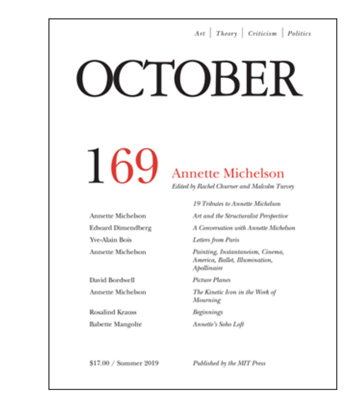 One of Annette’s major accomplishments was co-founding the journal October in 1976. So it’s entirely appropriate that the newest issue is devoted to essays and memoirs celebrating her accomplishments. Edited by Rachel Churner and Malcolm Turvey, it gathers many exceptionally valuable items. It makes available two little-known pieces by Annette: her important essay from 1969, “Art and the Structuralist Perspective,” and a later reflection on Picabia and the cinema. There’s also a wide-ranging conversation with Edward Dimendberg.
One of Annette’s major accomplishments was co-founding the journal October in 1976. So it’s entirely appropriate that the newest issue is devoted to essays and memoirs celebrating her accomplishments. Edited by Rachel Churner and Malcolm Turvey, it gathers many exceptionally valuable items. It makes available two little-known pieces by Annette: her important essay from 1969, “Art and the Structuralist Perspective,” and a later reflection on Picabia and the cinema. There’s also a wide-ranging conversation with Edward Dimendberg.
Yve-Alain Bois analyzes her early, Paris-based art reviews and journalism, including many extracts and printing in toto her very first piece in the New York Herald Tribune. (The first sentence uses one of her favorite words: radical.) There are lengthy tributes from students, colleagues, artists, filmmakers (Gitai, Rainer, Ken Jacobs). Babette Mangolte contributes portraits and some images of Annette’s legendary loft. In all, this is a monumental undertaking and essential for anyone who wants to understand Michelson’s unique stance at the crossroads of film, visual art, critical theory, and Continental philosophy.
The recollections go far toward humanizing a figure who was for many of us a forbidding presence. I met Annette in late 1972, when I interviewed for a job at New York University. She scared me. (I wasn’t alone.) A few years later, when I did a visiting stint there during Noël Carroll’s leave, she proved much less intimidating. Maybe I was less skittish, or she was more mellow. She took a shine to Kristin, and we developed a mutually teasing friendship. I enjoyed her unusual habits, such as playing Berg on her turntable at ear-splitting pitch.
The last time I saw her was in March 2006. She had recently moved from her loft to a new place in midtown, and she was surrounded by boxes of books. Though somewhat frail, she insisted we go out for lunch. We talked about Eisenstein, Godard, and the history of the Anthology Film Archive.
Years before, feeling frisky during a sabbatical, I sent some friends the photo you see above, accompanied by the following text.
From Moscow Weekly (7 November 1993)
INTERACTION OF SOVIET MONTAGE CINEMA AND NEW AMERICAN AVANT-GARDE CONFIRMED BY NEWLY DISCOVERED PHOTO
Glasnost’ has brought many unexpected revelations, but few have been so striking as the proof that there existed an objective relationship between revolutionary Soviet filmmaking and the New York avant-garde cinema of the 1960s.
Until now, a continuity between the experimental Montage directors and the “New American Cinema” of Stan Brakhage and Hollis Frampton seemed an academic flight of fantasy. Many scholars had posited such an affiliation, but hard evidence had been lacking. What could the Marxist cinema of the 1920s have offered the apolitical formalists of the post-Beat generation?
Plenty, it now turns out.
While rummaging in old photographs at Goskino, a young Russian filmmaker, Yevgenii Zhirmunsky, found a crumpled envelope labeled “Conference 1935: Miscellaneous.” The notation referred to the notorious 1935 All-Union Conference of Soviet Cinematography, at which the major directors capitulated to Stalinist demands for Socialist Realism.
Highlight of the Conference was the ritual humiliation of Eisenstein, the most celebrated Soviet director, and the elevation of the Vasilievs’ Chapayev, soon to become the prototype of Socialist Realism.
Zhirmunsky discovered that the envelope held several snapshots of cineastes dozing through papers or denouncing their comrades from the lectern. Most informative, however, was an original version of the famous photo of the premiere directors–Eisenstein, Dovzhenko, Kuleshov, Pudovkin, and others. Zhirmunsky was startled to discover that versions of this photo, reproduced in both East and West for sixty years, had eliminated a key participant at the Conference.
Airbrushing and photomontage were common in the Stalin era. When a political figure fell from favor, he was often deleted from all photographs. Sometimes other figures were added in this Bolshevik version of “virtual reality.”
Now, thanks to Zhirmunsky’s discovery, film scholars know that an influential figure of the New York avant-garde attended the 1935 Conference. Professor Annette Michelson, critic, teacher, and tireless promoter of the New American Cinema, was present and, to judge by the photo, became a central participant in the events taking place.
The photo shows her wearing a loose sweater and blue jeans, characteristic garb of New York bohemians. While a woman seems out of place amid the gabardine-suited directors, Michelson’s intensely serious expression suggests that she followed the debates with keen interest. Her proximity to Eisenstein, and his almost adoring expression, suggests a special affinity between them.
Zhirmunsky surmises that Michelson, long an advocate of the historical continuity of the Soviet avant-garde and the New American film, conveyed to her Manhattan contemporaries the essential insights of the revolutionary directors. This would provide the “missing link” long sought for between the two movements.
Not surprisingly, Michelson has been the most outspoken advocate of the continuity of the two traditions.
Zhirmunsky surmises that Michelson’s “formalism” was anathema to authorities and led to her being deleted from the photo.
The photo is to be published in the US journal October this fall, prefaced by an essay by Zhirmunsky detailing the facts behind his extraordinary discovery.
And he persists in his quest for glasnost’ treasures. “I’ve found some new film footage of the taking of the Winter Palace,” he remarks. “There’s a chap in one shot who seems to be Fredric Jameson.”
My friends assured me that Annette would enjoy it. Apparently she did, because she responded in kind.
Dear Professor David Bordwell,
Professor Annette Michelson asks me, in her present absence from New York, to answer your most kind forwarding to her and to express her profound thanks. I communicated to her your message by telephone last night in California where she was delivering a keynote address at a Maya Deren conference and speaking, as fate would have it, on the Deren-Eisenstein relation.
You can, of course, imagine the extremely great gratification she feels about E. Zhirmunsky’s* discovery. This is a true resurrection that will heal an error and correct a wound maintained for more than a half century! Well, once again, we see that truly Truth is the daughter of Time. Of course you and I know that Professor Michelson, with her usual modesty, rejoices not for herself alone, but for Film History and for all those, who like yourself, labor to its greatest glory.
Professor Michelson found most interesting, of course, your hermeneutics of the original version. She suggested, however, that I communicate to you (although not for publication) her personal interpretation, based, of course, on her living memory of the fateful occasion. You will have noticed that everyone in this picture is smiling or laughing; everyone but Pudovkin, who seems to be explaining something and Professor Michelson (who was , of course at that time, far from being a tenured full Professor, in fact, she had not yet begun the graduate studies from which she … but that is another story).
The reason for this is that Professor Michelson had just challenged the famous director and actor on a point involving the famous debate between himself and Comrade (this is, of course, old style way of speaking) Eisenstein. Perhaps you have some memory of this about building blocks or opposing forces?
Such, it would appear, was the strength of Professor’s challenge coming, in addition to boot, from an American young girl, that the general reaction – even from Donskoi and Bek-Nazarov – was “It appears like the Amerikanska has you, there, Comrade! What have you got to say for yourself now?”
And while Eisenstein is certainly admiring of this daring young female who defends his more correct Hegelian position, he is also clearly amused by Pudovkin’s being flustered by her so that he can hardly defend himself.
For everyone but the two protagonists, the event was a subject of amazement and amusement that lasted far into the Moscow night and beyond, but as you can see from the transcripts of the Conference, it was erased from the record. Perhaps one day, Zhirmunsky or some bold graduate student will turn up the handwritten transcript of this important vis à vis. In the meantime, all heartfelt thanks to you, Professor Bordwell, in Professor Michelson’s name,
Yours sincerely,
R.I. Durakova, Research Assistant, The Post-Revolutionary Project
*Do you have his patronymic, since we would like to write and thank him?
I learned from this that even a sophomoric jape can help cement a friendship. Stuart Liebman, one of her most devoted friends, tells me that Annette continued to enjoy that picture in her final days. Her sense of humor is only one of the many things that make me glad to have known her.
The group portrait is discussed in Annette Michelson, “From Magician to Epistemologist: Vertov’s The Man with a Movie Camera,” reprinted in October (162 (Fall 2017), 113-132. The essay was first published in Artforum in 1972. She notes that Jay Leyda suggested that the photo might have been misdated and was taken later than 1935.
For discussions of Soviet creative retouching of photographs, see David King’s The Commissar Vanishes.
Thanks to Malcolm Turvey for conversations around this issue of October, which also includes an extract from my book Making Meaning.
Doctored photograph of the 1935 group portrait, with Michelson removed and a generic comrade substituted.
Venice 2019: Repremieres
The Spider’s Strategem (1970).
Kristin here:
The policy at the Venice International Film Festival is to show only world premieres of films. Luckily that includes premieres of restored prints of classic films. These form a major thread in the program here, and this year had been particularly rich in older films that have been unavailable or available only in incomplete or poor prints. We have been catching up with some favorites and were introduced to unfamiliar ones.
The Spider’s Strategem (1970)
Back in the mid-1970s, David and I taught Bernardo Bertolucci’s film, which he made directly after the better-known The Conformist (also 1970). Thanks to the New Yorker print, we came to know it well, and when we wrote Film Art: An Introduction, an example of it went in and has stayed in. David analyzed the film’s storytelling principles at length in Narration in the Fiction Film.
The film came out in VHS versions in the US and UK, both out of print, but it never was released on DVD or Blu-ray. Now it returns in a stunning restoration from Fondazione Cineteca di Bologna and Massimo Sordella. (The restored version is out on Blu-ray in Japan, but without English subtitles.)
The plot involves a young man, Athos Magnani, who returns to the village where his father, who shares his name and appearance, gained a reputation as a bold leader of a small resistance group during the 1930s. He was also mysteriously murdered. The father’s mistress, Draifa, urges his son to stay and investigate the crime, and, it is hinted, to take his father’s place in her bed.
Young Magnani does investigate, but he quickly becomes uncertain as to which villagers were his father’s friends and which his enemies. He also finds himself targeted with threats of violence. Flashbacks mix scenes of past and present with no attempt to differentiate them via period props, changing ages, or stylistic contrasts. The ambiguities, which continue to the end, are not surprising, given that the literary source was a Jorge Luis Borges short story.
Whether or not one enjoys the teasing plot, the visuals are enough to provide delight. The cinematography was done by two major Italian cinematographers: Franco Di Giacomo (The Night of the Shooting Stars, Il Postino) and Vittorio Storaro, known for his bold use of color (Dick Tracy, Tucker: The Man and His Dream, and Tango). The result (see top) is like a blend of classical paintings and an Italian fruit stall.
Now all we need is a Blu-ray release worthy of the print shown here.
Maria Zef (1981)
This was Italian director Vittorio Cottafavi’s penultimate work, made after he has worked almost exclusively in television since the beginning of the 1960s. It has a pleasantly old-fashioned look, perhaps not too surprising in that Cottafavi says he conceived it in 1938, two years after the source novel appeared. He was not able to make it until 1981, when it was seen a project local to the Friuli region of northeastern Italy.
Some internet sources list it as a TV series, but IMDb and others treat it as a film. Certainly it looks like a film and seems to have no obvious pause points. But it was produced by RAI and was shot in the TV-friendly Academy ratio rather than the wider formats that were standard by the 1980s. (While I was watching it, I thought of it as a much earlier film and was surprised to find that it was made so late.)
Maria, an adolescent girl, is traveling with her irrepressible younger sister Rosute and her dying mother. They carry a cart full of domestic implements to sell. The two are taken in by their uncle, Barbe Zef, who made the spoons and other wooden housewares that the trio had been peddling. He’s a gruff fellow, and violent when drunk. Under the influence, he rapes Maria and tries to stifle her subsequent resentment as if his attack had been just a natural impulse.
The film was shot on location in the Italian Alps (above). The region of Friuli will be familiar to many film scholars and buffs who have traveled there for the “Giornate del Cinema Muto” silent-film festival in Pordenone.
The restoration was done by Rai Teche. With luck, the new print will travel abroad and introduce Cottafavi, an Italian favorite, to broader audiences.
[September 10: Thanks to blogger Manfred Polak for providing further information on Maria Zef. He provides a link to a brief piece on the film at the Cineteca de Friuli website. This piece (in Italian) says the film will play at the I Milleocchi festival in Trieste, 13-18 September 2019. The Cineteca also plans a DVD release with numerous supplements. Its earlier release of Vito Pandolfi’s Gli ultimi had optional English subtitles, so perhaps the Maria Zef DVD will as well.]
Mauri (“Life force,” 1988)
This restoration from the New Zealand Film Commission and Park Road Post Production should make available a nearly forgotten classic of New Zealand cinema. It remains the only New  Zealand feature with a Māori woman, Merata Mita, as sole director. (In 1972, To Love a Māori had been co-directed by the husband-wife team Raimi and Rudall Hayward.) Mita had previously made the first feature-length documentary by a Māori woman, Patu! (1983). Much of her career was devoted to documentary filmmaking.
Zealand feature with a Māori woman, Merata Mita, as sole director. (In 1972, To Love a Māori had been co-directed by the husband-wife team Raimi and Rudall Hayward.) Mita had previously made the first feature-length documentary by a Māori woman, Patu! (1983). Much of her career was devoted to documentary filmmaking.
The plot centers largely around an interracial love triangle. Māori woman Ramari is loved by Steve, a white farmer who was schooled alongside Māori children and retained Māori friends as an adult. His father, however, is a rabid and apparently crazy racist who tries a variety of pranks, some violent, to break up the match. Ramari loves a Māori man, Rewa, who harbors a dark secret that prevents him from marrying her.
This drama plays out against the intertwined doings of the family and circle of friends headed by the matriarch Kara. She tries to instill traditional values into her children, grandchildren, and the various troubled people she has treated as her own offspring. The film is set and shot in a tiny, declining village, Te Mata, in the East Cape area of the North Island, south of the now-thriving Hawke’s Bay winery region.
According to the biographical page linked above, “Mita said she had consciously rejected Pākehā traditions of storytelling and embraced a layered approach, in keeping with the strongly oral traditions of Māori. She told writer Cushla Parekowhai: “These are differences that Pākehā critics don’t even take into account when they’re analyzing the film.” Pākehā is the Māori word for white people.
There are rare films, and here I think of Charles Burnett’s To Sleep with Anger, that are entirely set in a specific non-white culture and make no attempt to explain that culture to a white audience. Clearly Mita was trying for the same approach. Her film met with some criticism for not following mainstream conventions of film narrative. Nevertheless, like To Sleep with Anger, Mauri draws in viewers with its drama and appealing characters. Today audiences with a greater openness to other cultures will most likely greet this restored version with greater sympathy and appreciation.
Death of a Bureaucrat (1966)
Tomás Gutiérrez Alea is undoubtedly Cuba’s most famous and revered director. Even those with the most passing knowledge of Cuban cinema will know such titles as Memories of Underdevelopment (1968) and Strawberry and Chocolate (1993). Death of a Bureaucrat is another familiar title, restored by the Academy Film Archive and the Cinemateca de Cuba. The screening was introduced by our old friend Joe Lindner, Preservation Officer at the Academy Archive.
The film is essentially a slapstick farce on a rather unlikely topic, the burial and reburial of the titular bureaucrat. He was a man who distinguished himself by inventing a machine to mass-produce the white busts of political leaders which stand in every government office in Communist countries (and which resemble the bust on the bureaucrat’s tombstone, above). The plot, however, is set off when it is discovered that as a tribute to such a genius, the dead man’s work card has been buried with him, and his widow needs it to receive her benefits.
The rest of the film is a series of escalating efforts by the man’s son to track down the exhumation order which the cemetery officials demand if they are to be able to rebury the body after the card is retrieved. Numerous stamps, signatures, and forms are required, all of which can only be provided by a single person–naturally different in each case. The hero becomes increasingly desperate and begins to try stealth, slipping into an office after closing hours and smuggling his father’s coffin into the graveyard to rebury it himself. All the while the grieving widow gathers all the ice her friends and neighbors can supply to prevent the body, kept at her house, from deteriorating.
The action is amusing enough, including one scene where a hearse is revealed to have a small plastic skeleton dangling from its rear-view mirror. The action does become somewhat repetitious and drawn-out, and one gets the feeling at times that the humor is perhaps aimed at an uneducated audience of workers and peasants, comparable to the Socialist Realism imposed upon filmmakers in the Soviet Union after the 1920s.
It’s interesting that such criticism of the workings of government would be permitted, and yet bureaucratic red tape seem to have been a somewhat safe target for Communist filmmakers, especially if presented as a sort of holdover of bourgeois practices. In the 1920s the Soviets had My Grandmother (Kote Mikaberidze, 1929) and The State Functionary (Ivan Pyriev, 1930), and Death of a Bureaucrat somewhat recalls them.
Extase (1933)
Each of the three years we have visited the Venice International Film Festival, there has been a preliminary evening where a restored early film has been shown. The first year saw the restored Rosita, the second Der Golem, both with orchestral accompaniment. This year there was an early Czech sound film, Gustav Machatý’s Ecstasy.
Having see the film only in the incomplete version that circulated in 16mm in the US for many years, I must say that I had not been impressed. The new restoration by the Národni filmový archiv, with much support from other archives, is a very different film indeed.
The story makes more sense now. It begins with the heroine, played by Hedy Kiesler-Lamarr (as she was then) as a young women who marries a wealthy older man. He turns out to have little interest in passionate love, and she is left on her own to be seduced by a young engineer working on a project near her husband’s estate. The film became famous for its scene of the heroine swimming nude, as well as her first, explicit for its day, love scene with the engineer.
The melodrama works its way out, with the rich man killing himself and the heroine, feeling guilty, leaving her lover. At this point, in the restored print, an abrupt switch to a lengthy sequence shows the engineer returning to work, with a joyous celebration of labor depicted in an imitation of Soviet films of the era. This incongruous ending to the plot comes quite unexpectedly, creating a film very different from the versions available hitherto.
Extase remains a less than wholly satisfactory film, but it now reveals its mixture of various influences of the era: the subjectivity of French Impressionism, the soft style of cinematography from the silent era, and in its ending, the propaganda and montage construction of Soviet cinema. Like Genina’s Prix de Beauté (1930), it’s an early-sound effort to preserve the aesthetics of mature silent cinema.
The evening definitely provided a new, startling version of a hitherto mutilated classic.
Thanks to Paolo Baratta and Alberto Barbera for another fine festival, and to Peter Cowie for the invitation for David to participate in the College Cinema program. We also appreciate the kind assistance of Michela Lazzarin and Jasna Zoranovich for helping us before and during our stay.
Our collaborator Jeff Smith provided a video analysis of another Alea film, Memories of Underdevelopment, for the Criterion Channel. He discusses it in this May blog post.
To go beyond our Venice 2019 blogs, check out our Instagram page.
September 10: Thanks to Hamish Ford and Lee Tsiantis for information concerning The Spider’s Strategem‘s releases on VHS and Japanese Blu-ray.
September 18, 2019: Thanks to Gareth McFeely for corrections on dates and spellings in the section on Mauri.
Mauri (1988).
The raptures of rigor: Roy Andersson’s ABOUT ENDLESSNESS at Venice 2019
About Endlessness (Roy Andersson, 2019).
DB here:
In the midst of the frenzy of fast cutting in films of the 1990s, a few directors reminded us of the virtues of simply putting your camera on a tripod and letting the action unfold in front of it. Abbas Kiarostami, Hou Hsiao-hsien, Kitano Takeshi, Tsai Ming-liang, and several other filmmakers reminded us that the fixed camera and long take, i.e. the “theatrical” cinema so despised in the 1920s and 1930s, still harbored great expressive resources.
It’s a lesson we have to keep learning–with Warhol and Tati in the 1960s, Akerman and Duras and Angelopoulos in the 1970s, Iosseliani in the 1980s, and not least with one of the greatest exponents of the tendency, Manoel de Oliveira. His 1963 film Rite of Spring initiated his persistent, endlessly inventive exploration of the tableau shot. Doomed Love (1978; briefly discussed here) is a superb example; Francisca (1981) is another, and we were lucky to catch a superb restoration on display in the Venice Classics section. I hope to write about it soon!
After four years of production, Roy Andersson’s Songs from the Second Floor was released in 2000 and established his distinctive approach to the tableau tradition. Since then he has made only three features, the most recent of which played in competition at Venice 76. Of course we had to see it, and to visit his press conference.
This is visionary cinema of a unique kind.
Landscapes of unhappiness, minor and major
Start with some brute facts. About Endlessness runs only seventy minutes (without credits), and it consists of 32 one-shot scenes. As in Andersson’s other films since 2000, most scenes stand alone, without narrative connection to others.
Some are bare-bones situations, as when a young man watches a young woman watering a plant, or when a father ties his little girl’s shoe in a rainstorm. Others unfold a dramatic crisis. A man bursts into tears on a city bus, complaining that he doesn’t know what he wants. A dentist, put off by a patient’s yowls of pain, simply walks out of the consultation and ends up in a bar.
Some shots draw on our knowledge of a broader story, as when Hitler stalks into one chamber of his bunker and his lieutenants, exhausted by the bombardment, sporadically salute him. He hardly seems to notice. A few tableaux present a recurring thread, like minimalist running gags. A man recognizes a schoolmate, but wonders why the man won’t greet him. A priest feels himself losing his faith, gets drunk while celebrating mass, and consults a doctor for advice. And one recurring image shows a woman cradled in a man’s arms floating in the sky–at one point drifting over the ruins of the bombed Cologne of World War II.
What makes Andersson’s cinema so fascinating is his effort to design intricate, gradually unfolding compositions that harbor powerful emotional expression. Dialogue is at a minimum; objects are arranged with the precision of still lifes. His people are often doughy and plodding, with hangdog expressions and complexions like pumice, living in a world dominated by grays and pastel browns. His movies reveal how many shades of beige there can be.
The grandeur of the distant framings accentuate the impotence of the characters. These sad creatures are caught in strict, unsympathetic perspective, all sharp angles and endless vistas. They stand exposed by flat, minimally sculptured lighting. “I avoid shadows,” he explained at the press conference. “I want to make pictures where people can’t hide. A light without mercy.”
The same mercilessness is seen in the settings, which may look fairly naturalistic but are wholly artificial. Andersson uses miniatures, background painting, and digital effects to create his picture-book landscapes. Streets, cities, train platforms are all the product of years of preparation. Like Tativille in Jacques Tati’s Play Time, Andersson’s sets create a beguilingly realistic version of a wholly fake city.
The sets are calculated to make sense from a single vantage point, as Renaissance paintings are. In a shot like the first one below, moving the camera would reveal the forced-perspective buildings outside.
Some of these landscapes are as eerie as de Chirico’s, but without any of the sensuous shading.
Which means that posture, gesture, and objects near and far have to carry the drama, however anecdotal it may be. The man who thinks his old friend has snubbed him tells us that the friend has a Ph.D. His wife consoles him (after all, they’ve been to Niagara Falls), but he’s still anxious. His puzzled fretfulness is carried by his slumped bearing, his plaintive expression, and his clinging to his slotted spoon. Meanwhile we hear his pasta simmering ever more loudly in the kettle in lower frame right, a light objective correlative to his annoyance.
Andersson teases us by letting us imagine how a micro-story might unfold. In a cafe, a woman sits alone, with no drink in front of her. She’s in the classic posture of waiting, A man eats dinner behind her (his cutlery clinks) and an empty table on far right bears the traces of another customer. In comes a large, lumpish fellow brandishing a bouquet. He hesitantly asks for Lisa Larsson. So it’s a rendezvous?
Nope. A bald man enters from frame left bearing two beers.
The lady doesn’t admit to being Ms. Larsson. Maybe she really isn’t, or maybe she found a better date. In any case, the newcomer turns and leaves, a bit sadly. Of course, there’s always the possibility that the absent customer on the right was his date. We, and he, won’t know.
Note, in passing, Andersson’s use of classic staging techniques. Tableau cinema needs to guide our attention through pictorial tactics such as central placement, frontal positioning, and patterns of blocking-and-revealing. By giving the bald man a central position in the format and letting him mask our view of the man eating in the corner, Andersson makes sure we’ll register the confrontation between him and the intruder.
Most of the tableaux are accompanied by a brief voice-over, a woman saying, “I saw…” followed by a single-sentence description of the action. Andersson claims to see her as a bit like Scheherazade, but she has as little commitment to a full story as he does. Her narration provides very little judgment on the scene but does supply a bit of information–often grim, as when we learn that a busker lost his legs in combat.
Indeed, war is a recurring motif in the film, making it bleaker than any of the other Andersson films I recall. Now the minor miseries and absurdities of modern life sit along a continuum of death and destruction. A sequence of spontaneous dance here, a father’s awkward love for his daughter there–these don’t wholly compensate for a wartime execution or the bombing of Dresden. The gags are fewer now, and Andersson’s fantastical but stubbornly tangible cities have never looked more oppressive. The idea of endlessness stretches in many provocative directions: the infinite vistas of city and sky, the pinpricks of guilt and frustration in everyday life, the obscene endlessness of war. Lucky are those who can in a gentle embrace float above it all.
Andersson’s last film, A Pigeon Sat on a Branch Reflecting on Existence, won the Golden Lion for Best Film in Venice in 2014. Maybe this one will too? It’s one of the best new films I’ve seen here this year. More on the others, in later entries!
Thanks to Paolo Baratta and Alberto Barbera for another fine festival, and to Peter Cowie for his invitation to participate in the College Cinema program. We also appreciate the kind assistance of Michela Lazzarin and Jasna Zoranovich for helping us before and during our stay.
We’ve written bits on Andersson’s films elsewhere in our blog entries. See our entries on tableau staging for lots more on how this stylistic approach works. I discuss the technique as well in On the History of Film Style and Figures Traced in Light: On Cinematic Staging.
To go beyond our Venice 2019 blogs, check out our Instagram page.
About Endlessness (2019).
Finding a form: The College Cinema at the Venice International Film Festival
This Is Not a Burial, It’s a Resurrection (Lemagang Jeremiah Mosese, 2019).
DB here:
For the third year I participated in the Mostra’s College Cinema, a wonderful program that funds and guides three features by up-and-coming directors and producers. (Details are here.) I’ve reported on the earlier sessions here and here.
This year my developing reaction to the trio of features was governed by what Kristin and I did the day before our panel. We saw two superb classics: Bertolucci’s The Spider’s Stratagem (1970) and István Gaál’s Current (1964). They reminded me of what ambitious filmmaking was like before the arrival of screenplay manuals dictating character arcs and first-act turning points.
In those days, a filmmaker was likely to find a distinct, even unique form for a story. The filmmaker would design the film organically, creating a large-scale shape that would let technique and dramatic structure build in relation to each other, not in accord with standard formulas.
Coupling via monitor
A good example is The End of Love, directed by Karen Ben Rafael. The Israeli Yuval and the French woman Julie have a child. He waits in Israel for a new visa, while Julie must manage child care under the pressures of her job in an architecture firm. Each begins to suspect the other of infidelity, and their families in each country add to the tension.
So much for a traditional “relationship” movie, whose ups and downs could have been presented in a standard way. But Rafael and her co-screenwriter Elise Benroubi hit upon a fresh way to trace the couple’s conflicts. Yuval and Julie are keeping in touch via a Skype-like video service, and we are completely confined to their exchanges in this medium. We see only what they see, in a series of to-camera shot/reverse-shots.
Some recent genre films have been “monitor movies,” like Paranormal Activity 4 (2012), Chronicle (2012), Unfriended (2014), and Searching (2018). But these exploit the device for suspense and horror. The End of Love lets the conditions of video communication structure the ongoing drama. A teasing opening suggests that the camera is lying in bed between the couple as they caress themselves; the next scene–a remarkable shot in itself (above)–reveals that video is their channel of communication.
As the film goes along, tensions between Yuval and Julie are presented as much through the mechanics of video exchanges as through the actors’ (very persuasive) performances. Unanswered calls signal a growing indifference. A mysterious shot wobbling through a dance club suggests either a phone accidentally turned on or a loud, defiant assault on the other person. I was especially taken by the moments when we get slight change of eyelines as characters look from the camera to study the display image of the other person.
The End of Love triggers a lot of ideas about how modern couples are led to expect that technology can overcome family problems. Being always online, always “in touch,” doesn’t mean that you’re engaging authentically with someone else. For all its power, the video hookup in the film creates an illusory intimacy, and its glitches stand for the aggravations, little and big, that come with physical separation. This thematic implication grows organically out of the creative decision to confine our viewpoint to what the camera can see and hear, but not heal.
Social drama into community myth
Another vigorous example of letting the material summon up the film’s form is This Is Not a Burial, It’s a Resurrection. Directed, written, and edited by Lemogang Jeremiah Mosese, it’s a poetic work that develops its imagery out of a dramatic situation.
The eighty-year-old Mantoa learns that her only surviving relation, her grandson, has died in a mining accident. After being consoled by her priest and the local choir, Mantoa tries to restabilize her life. But when she learns that her village is to be flooded for a dam project, she vows to save the bodies in the local cemetery–and to prepare her own grave.
This tale, set in Lesotho, is framed by a narrator telling us about her and her community. He sits in a blast of yellow light adjacent to a pool hall, and at intervals the story action pauses for his comments. The film takes its time–about 300 shots in two hours–to dwell on the details of her daily routine, such as the portable radio hanging from the wall, or Mantoa’s changing outfits.
But there are also more surreal images, such as Mantoa on a burned-out bedspring being slowly surrounded by sheep. The community that eventually supports her is presented as an almost abstract force, as are the out-of-focus government workers slowly hacking away at the perimeter of the village. The climax of the film makes powerful use of those figures as Mantoa confronts them in her boldest provocation of all.
Again a familiar situation–a tenacious elder tries to halt the destruction of a community (think Wild River)–is given fresh life through formal elaboration. Out of a primal conflict, Mosese generates a work of mythic dimensions. He does it through lustrous visuals, an evocative soundtrack, and a character who creates a legend that will live for generations.
Town and country
If The End of Love traces a jagged decline in a relationship, and This Is Not a Burial lifts a social conflict into spirituality, Lessons of Love finds another structure, this one aiming to express the inarticulate feelings of a man stuck in a situation. It’s a circle.
Yuri toils on his father’s farm, while his younger brother and sister try to avoid their responsibilities. Stolid, silent, and glum, Yuri harbors a good deal of anger, occasionally expressed in road rage. He relates to the world almost completely through physical contact.
Director Chiara Compara and her co-screenwriter Lorenzo Faggi start from a classic pattern: the migration of an innocent from the countryside to the city. This pattern is refreshed through a strategy going back to Neorealism: the insistence on the physicality of daily routines. A prolonged moment of Yuri tuning a radio recalls the famous scene of the maid’s morning ritual in Umberto D.
The early stretches of Lessons of Love stress the demands of farm work. The first shot is of a milk can, and soon we see logging, veterinary inspections, the purchase of a cow, and the dull evening meal. But we also get a sense of Yuri’s longing when he soberly eats during a TV love scene, and soon enough he’s visiting a strip club, watching as impassively as he did the TV show.
Through a tissue of routines, Yuri’s vague thoughts about escape emerge, and soon he is considering buying cowboy boots, dating Agata, and getting a construction job in town. That’s when the circular structure gets initiated, and new routines replace the old ones. Again, the details of hard labor aren’t stinted, and Yuri is challenged to break out of his smoldering solitude. Can a man who punches and embraces his favorite cow, and who furiously whacks a driver-side mirror, ever learn to talk to a woman who’s kind to him? The last shot of the film, discreetly echoing the first, provides the answer.
A fraught love affair, a defiant elder speaking up for a community’s heritage, and a lonely, locked-in man are familiar enough points of departure for a film. But these three College features offer fresh, rigorous treatment of their stories. Three acts and vulnerable-but-relatable heroes and heroines? Not necessary! There are other ways to go, as young filmmakers can show us.
Thanks as usual to Peter Cowie for inviting me to join the College Cinema panel, and to Savina Neirotti, the Head of the program. Thanks as well to other participants for lively conversation: Chaz Ebert, Glenn Kenny, Mick LaSalle, Michael Phillips, and Stephanie Zacharek. As ever, we appreciate the kind assistance of Michela Lazzarin and Jasna Zoranovich for helping us before and during our stay.
Glenn has a fine appreciation of the College films on rogerebert.com. He too was reminded of Wild River, but no surprise as we’re both nerds in this (and other) respects.
The End of Love (Karen Ben Rafael, 2019).












